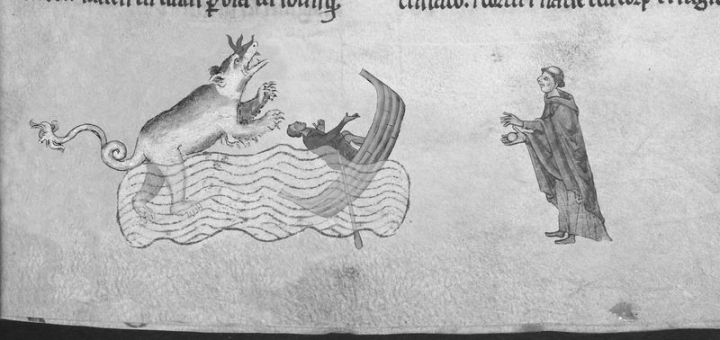April Fools’ Day Cryptids
Posted by: Craig Woolheater on April 3rd, 2013
On Monday, I asked if anybody had seen any April Fools’ Day pranks using cryptids.
Since then, I found and posted the Animal Legal Defense Fund Sues to Stop Texas Bigfoot Hunt press release;
and this: Loch Ness Monster Found at British Library.
Researchers at the British Library have found sensational evidence for the existence of the Loch Ness Monster. Hidden within the pages of a 12th-century manuscript is not only a description but also a drawing of the beast known to millions as Nessie.
Walter of Bingham (d. c. 1197) was a minor cleric from Nottinghamshire who, unable to fulfill his vow to go on the Third Crusade, made a pilgrimage to the holy sites of Scotland. William’s own manuscript of Itinerarium Scotiae (The Journey Through Scotland) has been long neglected , but shows the author’s fascination with Scottish history, customs and wildlife. One commentator has remarked that “Walter of Bingham is to Scotland what Marco Polo is to China”. The tone of The Journey Through Scotland emulates the writings of Walter’s famous mentor, Gerald of Wales, who wrote accounts of Ireland and Wales in the 1180s and 1190s.
Walter’s encounter with Nessie came one summer evening, as he approached the banks of the River Ness. Students of the Loch Ness Monster will be aware that in the earliest account, found in Adomnán’s Life of St Columba (written around AD 700), Nessie was seen not in the loch but in the neighbouring river; and this is corroborated by Walter’s story. Seeking safe passage across the river, Walter of Bingham asked a group of fishermen mending their nets, but they rejected his request with terror in their eyes. Next, walking downstream, Walter encountered a young boy dragging his coracle along the shore. Hesitating at first, the boy agreed to row Walter of Bingham across in return for a silver coin. They crossed without mishap, much to Walter’s displeasure, for he was self-confessedly thrifty; but as he watched the coracle heading back to the other shore, a great beast with fire sparking from its eyes suddenly erupted from below the waters, uttered an almighty roar, and then dragged the coracle and its unhappy occupant beneath the waves.
Walter of Bingham’s account provides firm proof of the existence of the Loch Ness Monster in the 12th century. But what is perhaps more remarkable is the drawing of Nessie which accompanies the text, now severely faded and barely visible with the naked eye. The drawing’s significance was first recognized by an international team of imaging scientists, cryptozoologists and manuscript experts, who for the past year have been analysing the British Library’s pictures of mythical beasts. Using a pioneering technique known as Re-Zoom Spectroscopy (RZS), the scientists took multiple photographs of the page in question, which were overlaid and processed using a “Guggenheim manipulator”. The resulting image demonstrates that Walter of Bingham made a careful depiction of Nessie, and can now be revealed as the earliest known picture of the Loch Ness Monster.

The Loch Ness Monster, as recovered using RZS©. Walter of Bingham is depicted on the right (an early example of a self-portrait), with the wretched occupant of the coracle about to be tossed into the water.
The shape of Nessie as recorded by Walter is hugely significant. Traditionally, the Loch Ness Monster is depicted in serpentine form, often with long humps protruding above the waves. The beast seen by Walter of Bingham most closely resembles a gigantic bear, and experts suggest that it may have been an enormous cousin of the modern-day Grizzly Bear or Kodiak Bear, now restricted to North America, or perhaps a descendant of the extinct Cave Bear. To judge by the survival of animal bones, the presence of a massive bear in remote, 12th-century Scotland is not entirely unexpected, and its behaviour indicates that, when observed by Walter of Bingham, it may have been defending its territory or guarding its young. But this is the first occasion that Nessie has received plausible identification as a bear: perhaps a relict population of bears survived in the vicinity of Loch Ness for many years, giving rise to the legend which surrounds it.
About Craig Woolheater
Co-founder of Cryptomundo in 2005.
I have appeared in or contributed to the following TV programs, documentaries and films:
OLN's Mysterious Encounters: "Caddo Critter", Southern Fried Bigfoot, Travel Channel's Weird Travels: "Bigfoot", History Channel's MonsterQuest: "Swamp Stalker", The Wild Man of the Navidad, Destination America's Monsters and Mysteries in America: Texas Terror - Lake Worth Monster, Animal Planet's Finding Bigfoot: Return to Boggy Creek and Beast of the Bayou.








